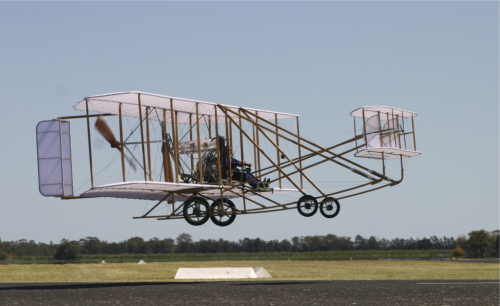
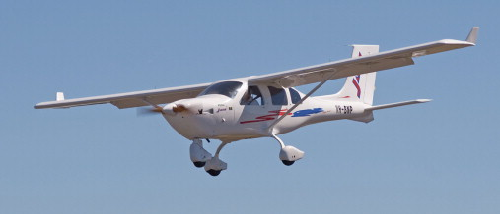
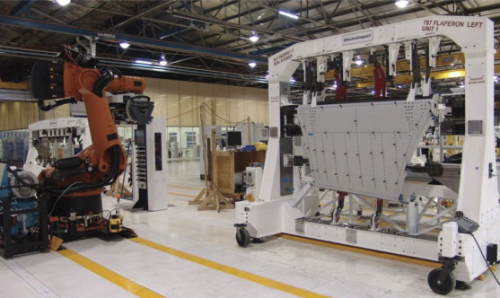
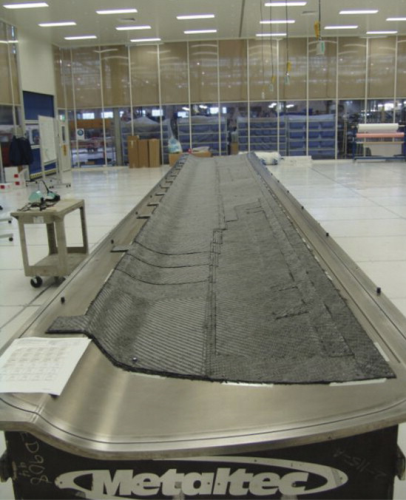
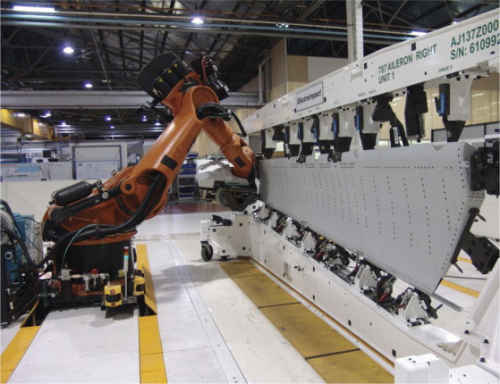
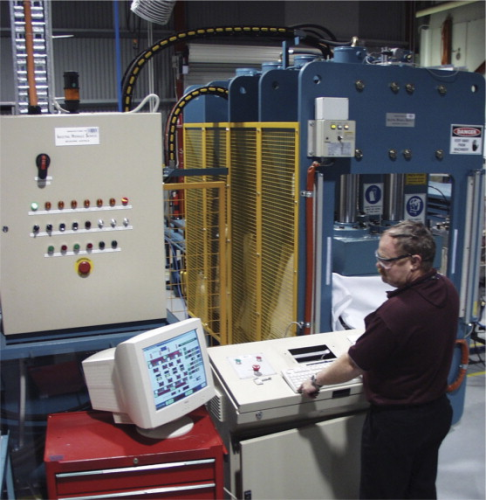
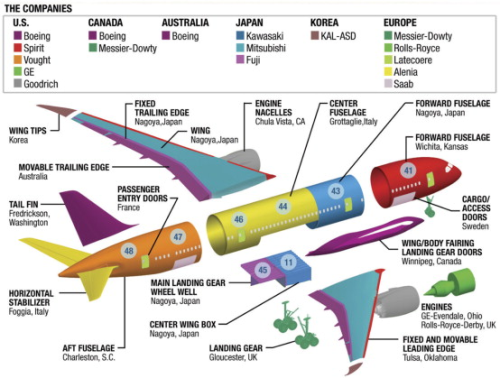
Interest at the show, held at Melbourne's Avalon Airport in March, focused particularly on the composites-intensive advanced new aircraft, both civil and military, that Australia is involved with. Leading on the commercial aviation side was the Boeing 787 Dreamliner, which is scheduled to make its maiden flight later this year. By adopting a 50% composite airframe, Boeing has stolen a march on its rival Airbus, capturing both the media spotlight and a large order tally even before the first flight.
Boeing had a large presence at the show, as befits the fact that, with a payroll of 3500 in Australia, it employs more people in that country than in any other outside the USA. These days a significant part of its Antipodean presence is its wholly-owned subsidiary Hawker de Havilland (HdH). HdH has a 75-year heritage which, at times, has included major parts of the Australian aircraft industry, notably the Commonwealth Aircraft Corporation (CAC) and the Government Aircraft Factory (GAF) – both of which it absorbed in its pre-Boeing days. While Boeing was trumpeting the merits of the B787 at Avalon, HdH focused on its aerostructural contribution to this programme.
HdH is producing, in carbon composite, all the movable surfaces (flaps, ailerons, spoilers) at the rear of the 787's highly efficient wings. John O'Hehir, head of the B787 programme at HdH, reported that work on these vital control surfaces is ‘moving along at a cracking pace.’
“In the last few weeks we have seen five rib ovens installed by Melbourne firm Furnace Engineering; the completion of our clean rooms, the first pre-production outboard flap pass its bird strike tests in Seattle, and tests carried out at the Australian Defence Science and Technology Organisation (DSTO) facility in Melbourne,” he explained.
Like other major 787 contributors, HdH is a vertically integrated partner responsible for the full definition, design and production of a complete structure or sub-system ready for integration into airframes on the final assembly line at Boeing, Seattle. ‘Build to print’ is becoming a less favoured model; aircraft OEMs seek instead to pass total responsibility for parts of the aircraft to partners, most of which share the financial risk in return for shares of subsequent revenue.
HdH worked with Boeing to develop a proprietary form of infusion for manufacturing the trailing edge parts. Cost savings due to being able to cure laid-up parts in ovens rather than expensive autoclaves are augmented by not having to store and process prepregs, says the company. Furnace Engineering, Melbourne, provided the ovens, in which hot air flows are tightly controlled to ensure the thermal conditions required at specific zones of parts under cure. Computational fluid dynamics (CFD) studies and a pre-production oven helped in finalising the design.
Currently tooling for the parts has been or is being qualified ready for use and test pieces are being built. Tooling worth more than $20 million has been produced by three Australian Tier 1 firms – Broens Industries, Metaltec International and Marand Precision Engineering – but only after trade body Tooling Australia had persuaded dozens of tooling companies to collaborate in seeking work on the Boeing programme. Some 20 smaller local companies are also involved as sub-contractors to the three Tier 1s.
Ensuring that the trailing edge sections are fit for service in high speed airflows, all weathers and at altitudes up to 40 000 ft requires a range of procedures from assessing over 3000 small composite material coupons to the full-scale structural evaluation of components sized up to the largest 10 m long by 4 m wide outboard flap. Helen Chapman, HdH head of testing for the 787, emphasises that all tests, including those for stress, strain, impact, bird strike, weather degradation and other hazards have to be completed by the time of first flight. Parts already subjected to bird strike tests – using 1.8 kg bird carcasses propelled at 280 kts – are said to have passed ‘with flying colours’. Chapman must ensure that arrangements are in place for checking that components can stand up to other abuse, from high-velocity hail stones to tools dropped by technicians to damage from service carts. Sub components undergo sonic testing inside a giant ‘speaker’, and simulated lightning. Some material coupons are subjected to water saturation for up to 45 days then heated and cooled to high and low temperatures respectively. Full-scale items suffer anything from ball bearing impact to load testing to 50% above the maximum levels anticipated in service.
For the crucial structural testing of complete full-scale items, Boeing and HdH chose Australian structural integrity specialist Aerostructures using (where required) facilities of the Defence Science and Technology Organisation (DSTO), part of Australia's Department of Defence. To test inboard and outboard flaps, for example, requires test rigs capable of exerting high controlled loads, to break point in some cases, and providing detailed results to certification standard – the first time this has been done for a Class A commercial aircraft in Australia. First development tests took place last August and full tests on production-standard items throughout the first half of this year.
Military
On the military front, Australia has a direct interest in the Lockheed Martin F35 Lightning II, otherwise known as the Joint Strike Fighter (JSF), now in development. The country is nominally due to procure up to 100 of these highly advanced combat aircraft and is one of eight partners to the US in the present system demonstration and development (SDD) phase. About 20 of its companies have won contracts on the programme. The aircraft, whose technology heritage extends back to the British Harrier ‘jump jet’, relies strongly on composites for its outstanding performance, especially its vertical capability. The type made a successful first flight on 15 December.
GKN Aerospace's Engineering Services Australia is responsible to senior contractor Northrop Grumman for designing and manufacturing composite and metal parts for the F35's centre fuselage. Some 30 GKN designers in Melbourne are actively involved, together with engineers working with Northrop Grumman staff in California. (GKNAES also provides engineering services for Boeing single-aisle and long-range types and for aircraft produced by EADS and Lockheed Martin). GKN and Lockheed Martin announced at Avalon that they are evaluating the business case for establishing a composites manufacturing facility in the Australian state of Victoria. This would combine technological know-how from both companies and start manufacturing in 2010, with deliveries to the JSF production line in Texas commencing the following year. It would create some 200 new jobs in Victoria.
However, with the F35 reportedly a year behind schedule and the country's existing combat aircraft nearing the ends of their service lives, Australia is having to consider a back-up plan. It may order up to 24 Boeing F/A 18 E/F Super Hornet fighters to serve pending the arrival of its fifth-generation fighter. The country remains committed to the F35, though, and signed up to participate in the next programme phase, covering follow-up development and production, within days of the December first flight.
“We believe the JSF is the right choice for Australia because it provides the right balance between capability and cost and does the full range of missions we need,” Air Vice Marshall John Harvey, manager of the New Air Combat Capability programme, told a media briefing at Avalon.
A Super Hornet acquisition would not be without benefit to Australian industry. In particular, HdH produces wing trailing edge flaps for the type using state-of-the-art carbon composite construction. Composite wing controls are indeed a strong suit for HdH which also produces wing flaps for all C130J Hercules military transports.
Another programme of local interest which might be subject to delay is the A400M airlifter, now in the advanced stages of development at Airbus Military. Australia had shown a keen interest in this aircraft but is now set to acquire four Boeing C17 Globemaster III tactical transports, this being the only western type capable of carrying M1 Abrams tanks and CH47 helicopters. Nevertheless, Airbus has not given up hope and was actively promoting its A400M, stressing that major sub-assemblies are now coming together in Spain for the first test airframe. A400M has extensive composite content, whereas the C17 is mainly metal.
General Atomics Aeronautical Systems was maintaining a high profile for its un-manned air vehicles (UAVs), particularly the proven Predator B and its maritime derivative the Mariner. Both have composite airframes. In a 29-day trial undertaken off north-western Australia last autumn, Mariner demonstrated its effectiveness in a maritime surveillance role, flying over 75 hours at up to 40 000 ft while collecting data on vessels operating within or through the country's north-western sea approaches. The UAV proved able to operate successfully with patrol craft, disseminating data to various official agencies including the Department of Immigration, the Fisheries Authority and the Quarantine Service. A flying period of nine days included two test flights from the Edinburgh base of the Royal Australian Air Force, and five from RAAF Learmonth in the north west of the country. Trial director Group Captain Bill Spears expressed his satisfaction with the trial series, adding his view that the experience gained would support the introduction into service of unmanned aerial systems (UAS).
Small aircraft
Away from the ‘big gun’ advanced platforms, it was good to see that Jabiru Aircraft Pty Ltd in Queensland still has a winner in the all-GRP Jabiru light high-winged monoplane. One flight school principal told Reinforced Plastics that this aircraft, highly popular among training schools as well as with private pilots, had enabled his school to run flying courses at a fraction of the cost of using its previous mainstay, a ubiquitous US model.
Representatives from Diamond Aircraft discussed the company's highly successful range of composite GA aircraft, now including the five-seater D-Jet. Adam Aircraft Australia said that one of its new composite very light jets just sold to an Australian customer is due for delivery in 2008.
Outside flying machines, one exhibit that caught the eye was an explosion protection container shown by Kilgore Ammunition Products, a member of the Chemring Group which has a presence in Victoria. The Episafe, from Netherlands company Futura Composites BV, is an open cylinder of an undisclosed resilient polymer (possibly a thermoplastic) reinforced with continuous fibre. Placed round a suspect package earmarked for detonation or an improvised explosive device, the Episafe contains the horizontal effects of the explosion, instead directing the force upwards to where it can disperse less harmfully. People standing only two or three yards from the explosion can survive, according to Kilgore's John Carter. In tests, Episafe has shown itself able to withstand the force generated by 1 kg of explosive (as a comparison, a hand grenade contains about 45 g of such material). This ‘bomblet attenuator’ is made in three sizes, 27, 33 and 70 kg. The 33 kg model is about 2 ft in diameter and has a wall around 2 inches thick.
Blast containment was also the theme of AML UK Ltd, in association with demonstrations by the British Army. Composite-based blast containing litter bins and devices suitable for post rooms, baggage areas etc are among its products, as well as tough composite panels said to be able to resist attacks from sharp implements, acids, salts, oils and most solvents. AML UK is also responsible for Bristol armour, which uses composites to provide ballistic and blast protection.
Hot repair
A hot future topic among those responsible for airframe maintenance will be the repair of advanced composites. Hot bonders will be required for curing patch and scarf repairs at the necessary elevated temperatures. An example of the latest generation of computer-based hot bonders was on display at the stand of Interturbine Advanced Composites Pty Ltd. Because the Brisk Heat bonder is more software based than previous ‘switch and wire’ competitors, it is said to be exceptionally versatile and user friendly. Users can pre-programme and store repair schemes via a touch screen and Windows interface. The system is Internet compatible, enabling upgrades to be downloaded as soon as they become available.
Other advantages, Reinforced Plastics was told, include a highly conformable heating pad which can be applied to repairs having complex curvatures, and a competitive price. Interturbine indicated that it offers a part-exchange scheme for users transitioning from other well-known brands, and that it will provide a spare machine should one in use develop a fault. At the time of the show, four systems – which the company started to distribute in Australia only recently – had been sold in the country, while serious discussions were on-going over another six.
Another computer hot bonder being publicised was that from Heatcon Composite Systems. The single-zone HCS 9000B and its dual-zone HCS 9200B sister both enable technicians to store repair programs in memory, monitor the repair process and provide a permanent record suitable for compliance with the relevant aircraft manufacturer's system repair manual (SRM).
Material suppliers keen to highlight involvement with the various advanced platforms included Hexcel, which was ‘proud to be supplying resins and fabrics’ to HdH for its B787 trailing edge contract. A key product from this supplier is Hex Flow RTM 6, optimised for resin transfer moulding (RTM) processes, and Hexcel worked closely with HdH to develop a specialist Hex Force fabric suitable for the company's cost-effective direct processing method.
Lavender Composites Pty Ltd featured a range of materials, consumables, process equipment and training, plus engineering services, required for the manufacture and repair of composite airframes. Products include custom-formulated quality epoxy systems and a range of syntactics used in honeycomb sandwich structures, both from US-based Magnolia Plastics.
Henkel Australia was happy to discuss its composite and honeycomb assembly products including mould release coatings, syntactic products for edge close-out, filling and splicing in sandwich structures, composite surfacing films and closed cell expanding syntactic films, film and paste adhesives.
Heath Tecna Aircraft Interior Solutions, which is based at Avalon Airport, makes extensive use of composites in its overhead bins, galleys, lavatories and cabin panelling products. Its through-life support programmes embrace most aspects of interior support including spares, repairs, maintenance and renovation.
Finally, a magnificent hark-back to the earliest days of flying was the world's only replica Wright Flyer that is certified to fly. Narromine Aviation in New South Wales used Dacron/polyester fabric over an Australian pine and spruce frame in constructing the replica. (For the purpose of this article, let wood qualify as a composite!)
